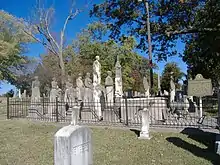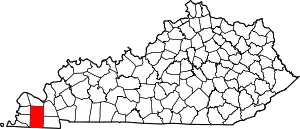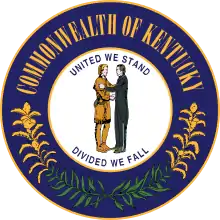Mayfield, Kentucky
Mayfield is a home rule-class city[8] in Graves County, Kentucky, in the United States. It is the county seat.[9] The population was 10,024 as of the 2010 U.S. census.[10]
Mayfield, Kentucky | |
|---|---|
.jpg.webp) Graves County Courthouse and Confederate monument | |
 Location of Mayfield in Graves County, Kentucky. | |
| Coordinates: 36°44′16″N 88°38′24″W | |
| Country | United States |
| State | Kentucky |
| County | Graves |
| Established | 1824[1] |
| Incorporated | 1846[1] |
| Named for | Mayfield Creek[2] |
| Area | |
| • Total | 7.35 sq mi (19.03 km2) |
| • Land | 7.31 sq mi (18.94 km2) |
| • Water | 0.03 sq mi (0.09 km2) |
| Elevation | 476 ft (145 m) |
| Population (2010) | |
| • Total | 10,024 |
| • Estimate (2019)[4] | 9,817 |
| • Density | 1,342.22/sq mi (518.27/km2) |
| Time zone | UTC-6 (Central (CST)) |
| • Summer (DST) | UTC-5 (CDT) |
| ZIP code | 42066 [5] |
| Area code(s) | 270 & 364 |
| FIPS code | 21-50898 [6] |
| GNIS feature ID | 0497715 [7] |
| Website | mayfieldky |
History
Mayfield is in the center of the Jackson Purchase, an eight-county region purchased by Isaac Shelby and Andrew Jackson from the Chickasaw people in 1818. Mayfield was established as the county seat of Graves County in 1821, and the county was formally organized in 1823. John Anderson is believed to have been the first European-American settler, arriving in 1819 and building a log home on Mayfield Creek. In December 1821, Anderson was appointed county court clerk and moved about two and a half miles to the site that became Mayfield. According to Trabue Davis, the town's name originates indirectly from a gambler named Mayfield, who was kidnapped about 1817 at a racetrack near what is now Hickman. He was carried to the site of today's Mayfield, where he carved his name into a tree in hopes that someone would see it. He tried to escape, but drowned trying to cross what is now called Mayfield Creek. The town took its name from the creek.[2]

The completion of the Memphis, New Orleans, and Northern Railroad in 1858 connected Mayfield with the outside world. Beginning with the founding of the Mayfield Woolen Mills in 1860, manufacturing clothing became the main industry in Mayfield for the next hundred years. The town was also a major market for loose-leaf tobacco, and was part of the Black Patch, where Dark Fired Tobacco was processed.
During the Civil War, the Jackson Purchase area, including Mayfield, strongly supported the Confederate cause. It has been called "Kentucky's South Carolina".[11] On May 29, 1861, a group of Southern sympathizers from Kentucky and Tennessee met at the Graves County Courthouse to discuss the possibility of joining the Jackson Purchase to West Tennessee. Most records of the event are lost, probably due to an 1887 fire that destroyed the courthouse.
In 1907, Fulton County judge Herbert Carr recalled that the Mayfield Convention adopted a resolution for secession. An historical marker in front of the Graves County courthouse now proclaims this as fact. However, records of the meeting kept by a Union sympathizer do not mention any such resolution. Historian Berry Craig argues that the convention believed Kentucky would eventually secede and a resolution to break away was unnecessary. Surviving records do show that the convention adopted resolutions condemning President Abraham Lincoln for "waging a bloody and cruel war" against the South, urging Gov. Beriah Magoffin to resist Union forces, and praising him for refusing to answer Lincoln's demand for soldiers. They also condemned the Federal government for providing "Lincoln guns" to Union sympathizers in eastern Kentucky. The convention nominated Henry Burnett to represent Kentucky's First District in Congress. The Mayfield Convention was followed by the Russellville Convention, which created the provisional Confederate government of Kentucky.[12]
During and after Reconstruction, there was considerable white violence against blacks in the county. In one week in late December 1896, four black men were lynched in Mayfield. After Jim Stone was lynched, whites became fearful after hearing that blacks were arming to retaliate. They called for reinforcements from Fulton County, and fatally shot Will Suett, a young black man getting off the train. The large white mob killed two more African-American men before the violence ended. Whites also burned four houses of African Americans.[13]
In this area, there was long dominance by the Democratic Party in local elections, achieved by violence and intimidation of Republicans. The state completed the suppression of competition by disenfranchising blacks at the turn of the 20th century.
During the Civil Rights Movement of the 1950s and 1960s, the local schools were slow to integrate, but they finally did so without violence. The "Mayfield Ten", ten black students from the segregated Dunbar High School, were allowed to register in 1956 at all-white Mayfield High School.
In 2000, Mayfield was shocked by the murder of Jessica Currin, a local resident. The case was finally closed nearly seven years later with the help of a local amateur investigator and a British journalist.
On May 10, 2016, an EF3 tornado passed just north of the city limits, resulting in ten injuries.[14]
Wooldridge Monuments

Mayfield is home to the Wooldridge Monuments, a series of historical monuments located in Maplewood Cemetery. They were built for Colonel Henry G. Wooldridge from 1892 until Wooldridge's death on May 30, 1899, to commemorate family members and other loved ones. The lot has been called "The Strange Procession That Never Moves."[15]
Geography
According to the United States Census Bureau, the city has a total area of 6.9 square miles (17.9 km2), of which 0.03 square miles (0.08 km2), or 0.43%, is water.[10]
The Purchase Parkway forms a bypass to the northwest of Mayfield, running along or close to the city limits. Access is from Exits 21 through 25. The parkway leads northeast 28 miles (45 km) to Interstate 24 near Kentucky Dam, and southwest 22 miles (35 km) to Fulton. U.S. Route 45 leads north from Mayfield 26 miles (42 km) to Paducah on the Ohio River and southwest to Fulton. Kentucky Route 80 leads southeast 24 miles (39 km) to Murray.
Climate
The climate in this area is characterized by hot, humid summers and generally mild to cool winters. According to the Köppen Climate Classification system, Mayfield has a humid subtropical climate, abbreviated "Cfa" on climate maps.[16]
Demographics
| Historical population | |||
|---|---|---|---|
| Census | Pop. | %± | |
| 1830 | 44 | — | |
| 1860 | 556 | — | |
| 1870 | 779 | 40.1% | |
| 1880 | 1,839 | 136.1% | |
| 1890 | 2,909 | 58.2% | |
| 1900 | 4,081 | 40.3% | |
| 1910 | 5,916 | 45.0% | |
| 1920 | 6,583 | 11.3% | |
| 1930 | 8,177 | 24.2% | |
| 1940 | 8,619 | 5.4% | |
| 1950 | 8,990 | 4.3% | |
| 1960 | 10,762 | 19.7% | |
| 1970 | 10,724 | −0.4% | |
| 1980 | 10,705 | −0.2% | |
| 1990 | 9,935 | −7.2% | |
| 2000 | 10,349 | 4.2% | |
| 2010 | 10,024 | −3.1% | |
| 2019 (est.) | 9,817 | [4] | −2.1% |
| U.S. Decennial Census[17] | |||
As of the census[6] of 2000, there were 10,349 people, 4,358 households, and 2,667 families residing in the city. The population density was 1,549.8 people per square mile (598.2/km2). There were 4,907 housing units at an average density of 734.8 per square mile (283.6/km2). The racial makeup of the city was 60.57% White, 13.31% African American, 0.21% Native American, 0.37% Asian, 3.48% from other races, and 2.07% from two or more races. Hispanics or Latinos of any race were 25.86% of the population. Recent years have seen a large influx of Amish residents who farm in the county.
There were 4,358 households, out of which 26.9% had children under the age of 18 living with them, 42.4% were married couples living together, 15.6% had a female householder with no husband present, and 38.8% were non-families. 35.3% of all households were made up of individuals, and 18.9% had someone living alone who was 65 years of age or older. The average household size was 2.27 and the average family size was 2.89.
The age distribution was 23.3% under the age of 18, 9.2% from 18 to 24, 24.9% from 25 to 44, 20.9% from 45 to 64, and 21.6% who were 65 years of age or older. The median age was 39 years. For every 100 females, there were 86.0 males. For every 100 females age 18 and over, there were 80.0 males.
The median income for a household in the city was $20,400, and the median income for a family was $27,463. Males had a median income of $29,324 versus $18,575 for females. The per capita income for the city was $15,327. About 23.4% of families and 27.5% of the population were below the poverty line, including 40.4% of those under age 18 and 15.9% of those age 65 or over.
Despite previously being in a dry county (Graves), sales by the drink in restaurants of the city limits of Mayfield seating at least 100 diners and at the Mayfield Golf & Country Club are allowed. In 2016, Graves County voted to become a wet county.
Media
Local media in Mayfield includes the Mayfield Messenger, a three-day (Sunday, Wednesday, Friday) newspaper. Radio stations WLLE-FM, WNGO-AM, and WYMC-AM are licensed to Mayfield.
Sports
Mayfield was home to professional baseball's minor league Class D Kentucky–Illinois–Tennessee League (or KITTY League) Mayfield Pantsmakers (1922–24), Mayfield Clothiers (1936–38, 1946–55), and Mayfield Browns (1939–41).[18]
The Clothiers were the first team to integrate the Kitty League when they employed African-American and Mayfield native Mickey Stubblefield as a pitcher during the 1952 season. [19] [20]
Education
Mid-Continent University, formerly Mid-Continent Baptist Bible College, was located just north of Mayfield off U.S. Route 45. It closed after the spring 2014 term due to alleged financial (aid) mismanagement.
Mayfield Independent City School District was established on July 1, 1908, with the selection and meeting of its first Board Members, organized by Mr. W.J. Webb.[21]
Mayfield High School has won 12 Kentucky High School Athletic Association football championships in classes A and AA in a total of 24 title game appearances. At the conclusion of the 2015 season Mayfield moved into fourth place nationally with 846 all-time wins. Mayfield High School mascot is "Cardinals".
The Graves County High School Co-Ed Cheerleading Team won the titles of National Champions in 2006, 2007, 2009, 2010, and 2011 and State Champions in 2005, 2006, 2007 and 2008, 2010, and 2012. Graves County High School mascot is "Eagles.
Mayfield has a lending library, the Graves County Public Library.[22]
Notable people
- Lucien Anderson,[23][24] former United States representative
- Lon Carter Barton, historian.[25]
- David Boaz, libertarian political thinker, VP Cato Institute
- Andrew Boone,[26] former United States representative
- Billy Joe "Cornbread Red" Burge, billiards player.[27]
- Betsy Cook, singer, songwriter, musician
- Randy Galloway, sports journalist and Texas radio personality
- Rex Geveden, Chief Operating Officer of BWX Technologies.[28]
- Noble Jones Gregory,[23][29] former United States representative
- William Voris Gregory, former United States representative[23]
- Helen LaFrance, artist.[30]
- Bobbie Ann Mason,[31] author
- Kent Robbins,[32] songwriter
- Kevin Skinner, musician and America's Got Talent's 4th Season winner
- Robert Burns Smith, third governor of Montana[33]
- Chuck Taylor, professional wrestler
- Ellis Wilson, artist
References
- Commonwealth of Kentucky. Office of the Secretary of State. Land Office. "Mayfield, Ky". Accessed 25 August 2013.
- Davis, D. Trabue. Story of Mayfield Through a Century, 1823–1923.
- "2019 U.S. Gazetteer Files". United States Census Bureau. Retrieved July 24, 2020.
- "Population and Housing Unit Estimates". United States Census Bureau. May 24, 2020. Retrieved May 27, 2020.
- United States Postal Service (2012). "USPS - Look Up a ZIP Code". Retrieved 2012-02-15.
- "U.S. Census website". United States Census Bureau. Retrieved 2008-01-31.
- "US Board on Geographic Names". United States Geological Survey. 2007-10-25. Retrieved 2008-01-31.
- "Summary and Reference Guide to House Bill 331 City Classification Reform" (PDF). Kentucky League of Cities. Retrieved December 30, 2014.
- "Find a County". National Association of Counties. Archived from the original on May 31, 2011. Retrieved 2011-06-07.
- "Geographic Identifiers: 2010 Demographic Profile Data (G001): Mayfield city, Kentucky". American Factfinder. U.S. Census Bureau. Retrieved December 8, 2016.
- Craig, Barry. "Kentucky's South Carolina: The Secession Crisis of 1860–1861". Accessed 25 August 2013.
- Craig, pp. 339, 346–347, 352–353, 359–360
- "Race War in Mayfield, KY", NKAA: Notable Kentucky African Americans Database, 2003-2018, University of Kentucky Libraries; accessed 25 March 2018
- "EF3 Tornado Leaves Damage, 10 Injured in Mayfield, Kentucky; Flooding Leads to Water Rescues Near Nashville". The Weather Channel. Retrieved August 18, 2016.
- "The Strange Procession That Never Moves"
- "Mayfield, Kentucky Köppen Climate Classification (Weatherbase)". Weatherbase.
- "Census of Population and Housing". Census.gov. Retrieved June 4, 2015.
- "Kentucky-Illinois-Tennessee League - BR Bullpen". www.baseball-reference.com.
- "Mickey Stubblefield Negro & Minor Leagues Statistics & History - Baseball-Reference.com". Baseball-Reference.com.
- "On Mickey Stubblefield, who broke the color barrier in the Kitty League". 3 March 2013.
- "Archived copy". Archived from the original on 2012-03-07. Retrieved 2013-03-31.CS1 maint: archived copy as title (link)
- "Kentucky Public Library Directory". Kentucky Department for Libraries and Archives. Archived from the original on 11 January 2019. Retrieved 5 June 2019.
- Kestenbaum, Lawrence. "The Political Graveyard: Graves County, Ky". politicalgraveyard.com.
- United States Congress. "Lucien Anderson (id: A000201)". Biographical Directory of the United States Congress.
- "Interview with Lon Carter Barton, November 29, 1990". University of Kentucky Libraries. November 29, 1990.
- United States Congress. "Andrew Boone (id: B000629)". Biographical Directory of the United States Congress.
- Steven R (May 26, 2011). "10 Greatest Pool Hustlers of All Time". FryingPanSports.com.
- "Geveden Selected as NASA Associate Administrator". NASA. August 17, 2005.
- United States Congress. "Noble Jones Gregory (id: G000447)". Biographical Directory of the United States Congress.
- "Visions of the Rural South". Kentucky Educational Television. Retrieved December 27, 2016.
- "SignatureLIVE". Kentucky Educational Television. Retrieved 23 August 2019.
- Kent Robbins Archived September 8, 2007, at the Wayback Machine
- "Montana Governor Robert Burns Smith". National Governors Association. Retrieved October 10, 2012.
- Craig, Berry F. (Autumn 2001). "The Jackson Purchase Considers Secession: The 1861 Mayfield Convention". The Register of the Kentucky Historical Society. 99 (4): 339–361.
Further reading
- "All Mayfield under arms: excitement over the Kentucky race war," New York Times, 12/24/1896, p. 1
- "Peace reigns at Mayfield: Colored people petition for harmony and the race war is over," New York Times, 12/25/1896, p. 5.

